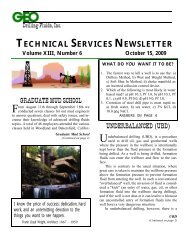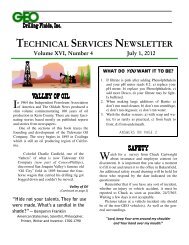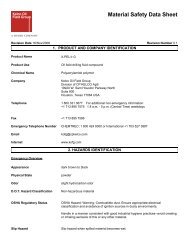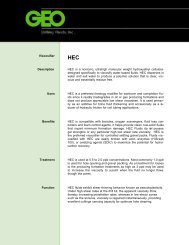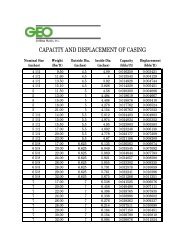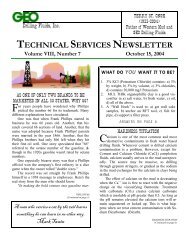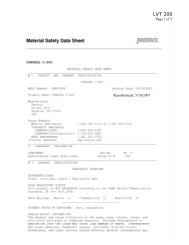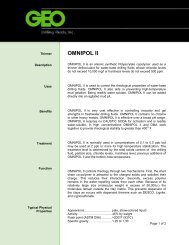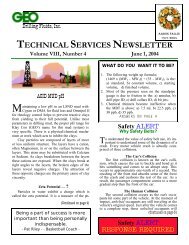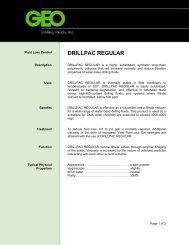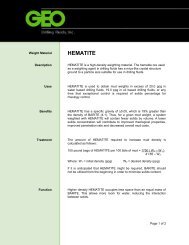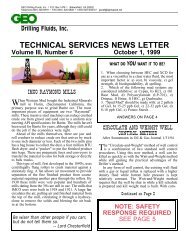Material Safety Data Sheet (MSDS) - GEO Drilling Fluids, Inc.
Material Safety Data Sheet (MSDS) - GEO Drilling Fluids, Inc.
Material Safety Data Sheet (MSDS) - GEO Drilling Fluids, Inc.
You also want an ePaper? Increase the reach of your titles
YUMPU automatically turns print PDFs into web optimized ePapers that Google loves.
PolyTeK + II<br />
Page 1 of 3<br />
<strong>Material</strong> <strong>Safety</strong> <strong>Data</strong> <strong>Sheet</strong> (<strong>MSDS</strong>)<br />
<strong>MSDS</strong> date: 06-May-2009<br />
SECTION I — IDENTIFICATION<br />
Manufacturer's Name:<br />
<strong>GEO</strong> <strong>Drilling</strong> <strong>Fluids</strong>, <strong>Inc</strong>.<br />
1431 Union Ave.<br />
Bakersfield, California 93305<br />
Phone Number: 661-325-5919<br />
Emergency Phone Number: 800-438-7436<br />
Product Name:<br />
PolyTeK + II<br />
Chemical Name and Synonyms: Proprietary Blend<br />
Chemical Family:<br />
Blend of Polymers and Salts<br />
CAS Reg. No:<br />
None<br />
SECTION II — INGREDIENTS AND HAZARD CLASSIFICATION<br />
Components:<br />
Composition:<br />
Proprietary blend<br />
All ingredients are non-hazardous.<br />
SECTION III — HEALTH INFORMATION<br />
Primary route of Exposure/Entry:<br />
Inhalation<br />
Acute Effects of Overexposure:<br />
Ingestion: None.<br />
Inhalation: Dust may cause irritation of nasal and respiratory passages.<br />
Skin: May cause irritation with repeated prolonged contact.<br />
Eyes: May cause irritation.<br />
Dust Hazard: Contains nuisance dust. Contains less than 0.03% respirable<br />
silica dust. Dust Control as Particulate Not Otherwise Classified (PNOC). The<br />
ACGIH Guideline for respirable dust is 3.0 mg/m 3 and 10.0mg/m 3 for total dust.<br />
The OSHA PEL for respirable dust is 5.0 mg/m3 and 15.0 mg/m3 for total dust.
PolyTeK + II<br />
Page 2 of 3<br />
SECTION IV — OCCUPATIONAL EXPOSURE LIMITS<br />
OSHA Permissible Exposure Limits (PEL):<br />
ACGIH Threshold Limit Value:<br />
See Section II.<br />
See Section II.<br />
SECTION V — EMERGENCY FIRST AID PROCEDURE<br />
For overexposure by swallowing: Do not induce vomiting. If large amounts<br />
are swallowed, give two glasses of water to drink and seek medical attention.<br />
For overexposure by skin contact: Wash with soap and water.<br />
For overexposure by eye contact: Immediately flush eyes with plenty of cool<br />
water for at least 15 minutes. Do not let victim rub eyes. Get medical attention<br />
immediately.<br />
For overexposure by inhalation: Immediately remove victim to fresh air. If<br />
Victim has stopped breathing give artificial respiration, preferably by<br />
mouth-to-mouth. Get medical attention immediately.<br />
SECTION VI — PHYSICAL DATA<br />
Appearance and color:<br />
Bulk Density:<br />
Tan powder.<br />
0.95 grams/cubic centimeter<br />
SECTION VII — FIRE AND EXPLOSION HAZARDS<br />
Flash Point & Method Used: Not Applicable<br />
Auto Ignition Temperature: >200ºF<br />
Flammable Limits in Air % by Volume: N/A<br />
Special Fire Fighting Procedures & Precautions: (Individuals should perform only<br />
those fire-fighting procedures for which they have been trained). Wear<br />
self-contained breathing apparatus with a full faceplate operated in the<br />
positive [pressure mode] when fighting fires.<br />
Unusual Fire & Explosion Hazards: May form explosive dust-air mixture<br />
Extinguishing Media:<br />
Water, CO2, foam, dry chemical<br />
Special Hazard:<br />
Product becomes slippery when wet.<br />
SECTION VIII — REACTIVITY<br />
Stability:<br />
Hazardous polymerization:<br />
Stable<br />
None
PolyTeK + II<br />
Page 3 of 3<br />
SECTION VIII — REACTIVITY (Continued)<br />
Conditions & materials to avoid: None<br />
Hazardous decomposition products: None<br />
SECTION IX — EMPLOYEE PROTECTION<br />
Control measures: Handle in the presence of adequate ventilation.<br />
Respiratory protection: Use nuisance dust mask.<br />
Gloves:<br />
Eye Protection:<br />
Dust protection:<br />
Personal hygiene:<br />
Engineering Control:<br />
Wear protective gloves to prevent drying of skin.<br />
Wear <strong>Safety</strong> Glasses<br />
Wear dust mask if engineering controls do not limit<br />
ambient dust.<br />
Do not get in eyes, on skin, or on clothing. Do not<br />
breathe dust. Wash thoroughly after handling. Wash<br />
contaminated clothing before reuse.<br />
Use with adequate ventilation. Keep container closed<br />
when not in use.<br />
SECTION X — ENVIRONMENTAL PROTECTION<br />
Spills: If small amounts are spilled, sweep and put in garbage. Use water with<br />
caution as wet material is slippery.<br />
Waste Disposal Method: <strong>Material</strong> can be dumped in a regular land fill site. Follow<br />
state and local regulations.<br />
SECTION XI — PRECAUTIONS: HANDLING, STORAGE AND USAGE<br />
Store in sealed containers in a dry place away from heat.<br />
Keep area clean. Surfaces subject to spills or dusting with this product become<br />
slippery when wet.<br />
The information presented herein is believed to be factual as it has been derived<br />
from the works and opinions of persons believed to be qualified experts;<br />
however, nothing contained in this information is to be taken as a warranty or<br />
representation for which <strong>GEO</strong> <strong>Drilling</strong> <strong>Fluids</strong>, <strong>Inc</strong>. bears legal responsibility. The<br />
user should review any recommendations in the specific context of the intended<br />
use to determine whether they are appropriate.




